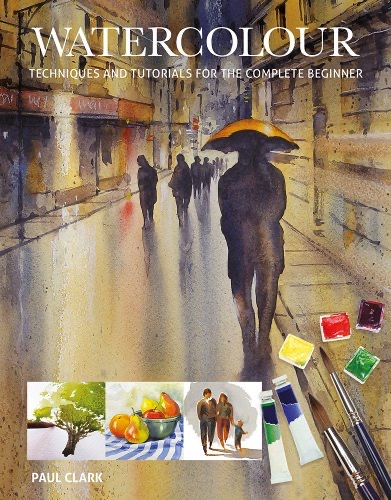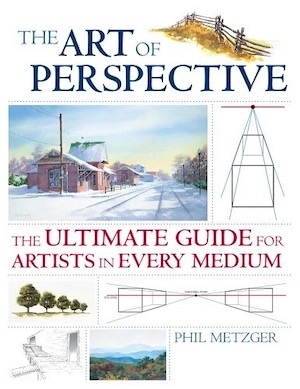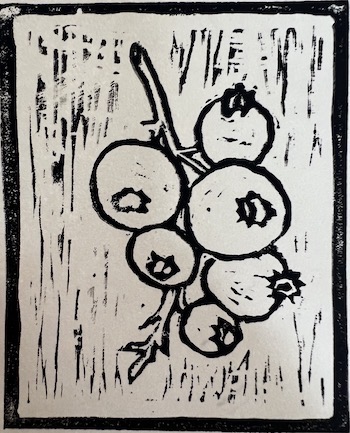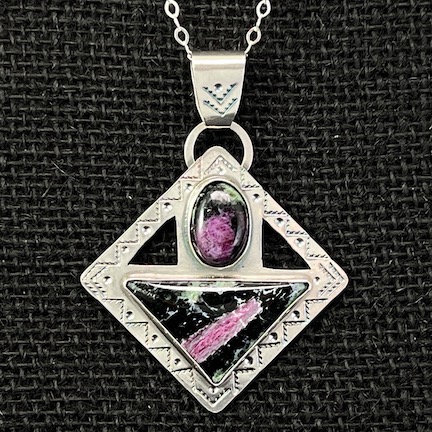I begin to explore visual arts: watercolor painting, drawing, and linocut printing.
In my previous post, I shared a lot of info about how I’ve been moving from creating with words to creating with my hands. In a quick review of that post, I realized that I didn’t share much about the art I’ve been exploring.
Painting

A publicity photo of Bob Ross.
It started with Bob Ross. You know — the white guy with the afro and soothing voice from the PBS The Joy of Painting series? I don’t recall when I started watching his videos, but I must have seen at least half of them. They’re all on YouTube and if you want something to calm you down or put you to sleep, I highly recommend them.
I wanted to try what he was doing. It looked so easy. But I had no artistic skills. I knew that if I wanted to follow along, I’d need the exact materials and tools he had. But the idea of working with (and cleaning up) oil paints was daunting, especially with so much time spent traveling every year. So I never hunted them down or bought any.
And then I started thinking about watercolor and how easy it was to clean up and how it didn’t matter if the paint dried in your palette. And I started watching YouTube videos about that, starting with videos by Jenna Rainey. I bought her book (as I’m prone to do), Everyday Watercolor, and started following along with her exercises, using her suggestions on brand and colors of paints, brand and sizes of brushes, and brands and types of paper. That’s how I wound up using Winsor & Newton Professional Watercolor paint in tubes, Princeton Heritage Series 4050 Synthetic Sable Brushes, and mostly 100% cotton cold press paper. Not the cheap stuff, but not crazy expensive, either.
It worked out well for a while — until I got bored painting leaves and flowers, which is apparently what she mostly paints. Around this time, I also saw a change in her videos. She’d obviously made the YouTube big time and had money to burn. She had a new studio and new camera set ups and was extremely self-promotional. As a YouTube creator — you know I have a YouTube channel of helicopter videos, right? — I know how they push us to bring in more subscribers, viewers, and money. I find it a turnoff when it goes beyond a certain level. She had gone beyond that level. So I stopped watching her videos.
(I’m so sick of YouTube creators caving to the demands of YouTube and video sponsors.)
I started watching other videos and reading other books and learning from other watercolor artists. Here’s a list if you’re interested:
YouTube Channels
I watch more YouTube than any other “television.” There is so much to learn online there if you are careful about what channels you watch for good info. Some are just plain crap. And I didn’t think I’d ever say this, but if you watch a lot of video, subscribe to Premium. It’s worth it just to get rid of those f*cking mid-roll ads that YouTube demands creators include. You can always fast-forward through the sponsor messages, which are prevalent on popular channels.
Anyway, here are the watercolor artists I watch most on YouTube these days.
-

Paul Clark looks like a nice guy, no?Paul Clark is a Brit who does a lot of line and wash painting, which I like. He explores other styles, too. He’s got a nice sense of humor and I enjoy watching him paint.
- Karen Rice Art features another Brit who does a lot of abstract watercolor painting, which I like. She’s very down to earth, with a good attitude.
- Erin Eno is a watercolor artist with lots of beginner and otherwise very easy tutorials. My only gripe with her is that she has a tendency to overwork her paintings — it’s like she can’t finish. I’ve also seen evidence that she experiments while she records video and has no idea how something will turn out. This occasionally leads her down a bad path, so beware if you follow along!
- The Mind of Watercolor is Steve Mitchell’s channel. I think it’s more advanced than some of the others, but it does include beginner videos. I like his style, mostly because he’s just explaining things one artist to another.
-

Diane Antone. Not sure about the hat.Diane Antone Studio is an ambitious channel with lots of new videos every week — she promises a new one every day. These days, many of her videos seem to be the obligatory video created solely to reward a sponsor for sending her product. To make matters worse, I’m pretty sure she’s the one who gets preachy once in a while. (After a while, they all blur together in my mind.)
- Paul’s Watercolor Studio (which is a new name for that channel) features another Brit named Paul. I don’t like his videos quite as much as Paul Clark’s and I noticed that he’s been doing a lot more promotional stuff than he used to. But he’s still a good resource.
There are a few more I watch once in a while, but I can’t really recommend any of them. So many of them are the same stuff over and over. Or “artists” talking about their life while they put blobs of paint on wet watercolor paper and then doodle on the result with permanent markers. Not something I can really learn from.
Books
I already mentioned one book. Here are a few others I like:
-

Paul Clark’s watercolor book. I bought the ebook version, which is easy enough to consult while I’m painting.Watercolour: Techniques and Tutorials for the Complete Beginner by Paul Clark. Yes, the same Paul Clark as the videos. It’s full of practical exercises that build on each other and are not limited to leaves and flowers. I’m working my way through them slowly in a watercolor notebook I have. Oddly, I can hear his voice in my head as I read the text.
- Watercolor Workbook: 30-Minute Beginner Botanical Projects on Premium Watercolor Paper by Sarah Simon. The best thing about this book is the color mixing recipes with places to paing your own version beside or beneath a sample. It’s challenging to get it just right. The exercises are pretty much the same, requiring you to outline a drawing and then color it in with the colors you mixed for the exercise. The paper is not “premium watercolor paper” by any stretch of the imagination. It’s thick and rough (like cold press) but is definitely not cotton and does not handle water well. I’m about 1/3 done with the exercises but I’m bored with them. Too much like a coloring book.
- The Complete Watercolorist’s Essential Notebook: A Treasury of Watercolor Secrets Discovered Through Decades of Painting and Experimentation by Gordon MacKenzie is basically a tips book, with a few exercises to illustrate each tip. It’s extremely thorough and has the kind of tips that it could indeed take decades to come up with. It’s the kind of thing I dip into once in a while to fill in the gaps of my knowledge.
The trouble is, watching videos and reading books is not the same as practicing what’s in those videos and books. I got immersed in other things in my life — traveling on my own boat, organizing my last season of flying work, prepping my house and packing for a prolonged trip (with a new house sitter to hold down the fort). I didn’t practice much and, when I did, I didn’t like the results. I was getting seriously discouraged no matter how many videos and books I consumed.
Drawing
And then there’s the simple fact that I can’t draw my way out of a paper bag.
I would never be able to make anything more interesting than blobs of color resembling flowers and trees viewed with my contact lenses out unless I learned how to draw the things I wanted to paint. I love the concept of line and wash — where you take a rough drawing done in permanent ink and add watercolor washes for color, highlights, and shadows — but the only way I could do such a thing was to start with someone else’s picture. That’s fine for practice, but I should be able to do better.
So I started watching videos and reading books about drawing. Here’s what I found helpful so far.
YouTube Videos

The Artisto Sketching Course on YouTube covers all the basics.
I’ve only seen one series of videos so far and I admit that I fell asleep watching them so I need to watch them again. It’s the Artisto Sketching Course on YouTube, which I discovered on a slip of paper that came in an Artisto notebook I bought. I can’t say much about it other than the fact that it’s a good primer that covers all the basics. Next time I watch them, I won’t be sitting on the sofa at the end of a long day. I’ll be sitting at a table with a sketchbook and sharp pencils in front of me.
Books
I’ve also looked at a few books, two of which I really like.
-

The Art of Perspective is an excellent reference for creating artwork that looks 3D.The Joy of Sketch: A Beginner’s Guide to Sketching the Everyday by Jen Russell-Smith is a book to help me learn how to draw. I’m working through the exercises in a sketch book. I think it’ll help me, but it’s too soon to tell.
- The Art of Perspective: The Ultimate Guide for Artists in Every Medium by Phil Metzger is an extremely well illustrated and easy to understand book about drawing in perspective. It’s something I need to understand to draw beyond the basics. I got this as an ebook from the library but think I may buy it.
Again, watching videos and reading books isn’t enough. I have to practice all this stuff.
Enter Linocut Printing
As if I didn’t have enough art-related hobby stuff to neglect, I got interested in another type of artwork: linocut printing. It started when I watched a YouTube video suggested by The Algorithm: Artist Demonstrating Picasso’s Reduction Linocut Technique. I was fascinated.
Linocut is a method of block printing where you carve a picture or design into a piece of linoleum (or something similar). You then apply ink to the cut surface, put a piece of paper on top of the cut, and rub the paper into the ink (or put it through a press) to transfer the image onto paper. Whatever you carve away has no ink on it so the paper stays white. Whatever remains raised is inked and creates the image. In a reduction linocut, the original linoleum carving is carved away before each color is applied. If you’re having trouble understanding this, do watch the video. It’s very good.

The Speedball kit I bought. The only thing missing was drawing skills and paper. I had one of those things.
I probably wouldn’t have gone any farther with this, but I happened to be in Hobby Lobby — which I honestly do hate with a passion but it’s the only art supply store in town now — and they had a Speedball Water-Based Block Printing Starter Set on sale for just $19.99. It had everything I needed (except drawing skills; I wish they came in the box) to create and print a linocut image. I bought it. I carved a simple seascape drawing with a lighthouse and ocean and waves and a crescent moon. It printed okay. (Not good enough to take a picture of since I don’t seem to have any pictures of it and now it’s packed away so I can’t take a picture.)
I was hooked.



The inspiration for my berry linocut print (top), my first print with chatter (middle), and my first colored in print (bottom).
What I wanted to do was create single color linocut prints and then use my watercolors to apply color and shading. It would be a line and wash, but the line would be a block print.
But I had a problem. The kit came with water-based ink. Even after it dried, it smeared when it got wet. It would definitely not work with watercolor paints. I needed oil-based ink. That wasn’t available locally, so I bought some online at Dick Blick. I bought Speedball Oil-based Relief Ink because that was the only brand I knew.
Meanwhile, I saw a simple watercolor painting on Mastodon that inspired me. I printed a copy of it and traced it onto Speedball Speedy Carve Block. Since the oil-based ink hadn’t arrived yet — Dick Blick has a great selection, but shipping takes over a week — I printed it with my water-based ink. It came out ok, although there was more “chatter” than I wanted. I’d need to do more carving to get rid of it, but that could wait until the next print, with the oil-based ink.
Although I knew I couldn’t use my watercolor paints to color my print in, I did have oil pastels — we called them “cray-pas” when I was in elementary school and I loved them. I used them to color in the berries as blueberries and apply a gradient background over the chatter. I was pleased with the results. It wasn’t perfect, but at least I liked it. (Ask anyone and they’ll tell you that I’m my worse critic.)
Of course, I needed to learn more. So I started watching more videos and reading more books. And I started learning about more interesting techniques to apply the colors, like chine collé. There was so much to explore!
YouTube Channels
Here are a few very good channels with linocut content worth watching:
- Handprinted has all kinds of videos about all kinds of printmaking. Very approachable.
- Laura Boswell Printmaker has more advanced tutorials and demonstrations that really show off what you can do with printmaking.
- Linocut Elina Artist is wonderful for demonstrations of reduction printing, although she focuses on the actual printing part and not the cutting part. The videos I’ve seen on this channel are not narrated, but they’re fun to watch. I especially like the “Red Rooster” demonstration.
Books

I absolutely love this book and can’t wait to work through all the exercises.
I only have one book about linocut printing (so far) and I love it. It’s Block Print Magic: The Essential Guide to Designing, Carving, and Taking Your Artwork Further with Relief Printing by Emily Louise Howard. It covers all the basics about tools and materials, explains how to keep cutting tools sharp, and then launches right into several projects, with lots of illustrations and step-by-step instructions.
I’m looking at a few other books online, but I think I’ll hold off until I get to Dick Blick in Washington DC next month where I hope to be able to browse better.
It’s All Packed and Shipped
I can’t do any artwork right now because I’ve packed and shipped all my materials and tools to my boat. After a long, dull summer at home, I’m finally heading back to Do It Now next week. I’m spending these last few days packing and cleaning and getting the house ready for its live-in house sitter. I barely had time to write this blog post, which I started this morning and then finished after a long day mowing my lawn, taking my trash on its 2-mile drive to “the curb,” and prepping my garden for winter.
It’ll take a few days to unpack everything I’ve shipped to the boat — I’m thinking there should be about 20 packages waiting for me when I arrive — and reprovision for the first leg of my trip south for the winter. I’ll be spending more nights at anchorages and should have plenty of time to get some practice in. With luck, I’ll be able to show off more work in a few weeks, assuming there’s work to show. I’ve also decided to do block printed holiday cards this year and will be working on those.
In the meantime, if you have any insight into any of this and want to share some of your favorite resources, please take a moment to leave a comment on this post. I’m really interesting in learning as much as I can from as many good sources as I can. Can you help? Don’t be shy! Leave a comment!






